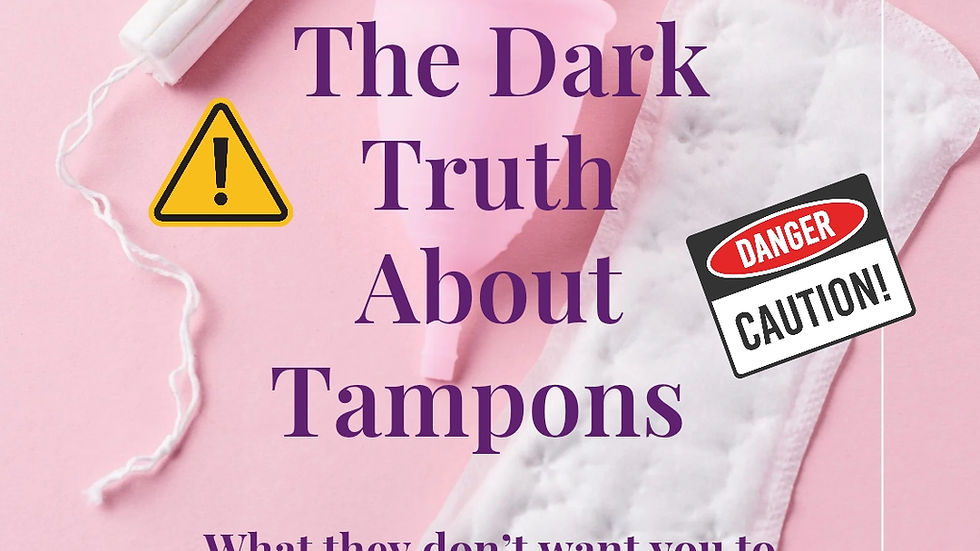🚨 The Hidden Dangers of Tampons: What You Need to Know
- Cathrine Rose

- Aug 31
- 3 min read
Updated: Oct 8
For decades, tampons have been marketed as the gold standard of period care — convenient, discreet, and “safe.” But behind the glossy packaging and billion-dollar advertising lies a reality that most women are never told: tampons can carry serious risks for your body and long-term health.
Let’s break down what’s really hiding inside that little cotton cylinder.
🧪 What’s in a Tampon?
Most tampons are not made from pure, organic cotton. Instead, they’re a blend of cotton, rayon, and synthetic fibers — often bleached and sometimes treated with chemicals for appearance or odor control. Here’s a closer look at the common offenders:
Dioxins → Byproducts of chlorine bleaching. Linked to hormone disruption, immune issues, endometriosis, and even cancer with long-term exposure.
Pesticide Residues → Cotton is one of the most pesticide-heavy crops. These chemicals don’t disappear during processing and can be absorbed directly into the bloodstream.
Fragrances & Phthalates → Found in “scented” tampons. Can trigger burning, itching, allergies, and disrupt your vaginal microbiome.
Rayon Fibers → Known to shed inside the vagina, irritating tissue and increasing infection risk. Also linked to Toxic Shock Syndrome (TSS).
Plastics & Bleach Residues → Polyethylene, polypropylene, and bleaching agents can cause dryness, irritation, and microplastic exposure.
Dyes & Colorants → Added for branding or aesthetic, but with no safety benefit. Vaginal tissue can easily absorb them.
⚡ Why This Matters
The vaginal wall is highly absorbent. Anything placed inside is absorbed directly into your bloodstream — bypassing the liver’s detox pathways. This means even small “trace amounts” of chemicals can have a stronger impact compared to other types of exposure.
🔥 Health Risks Linked to Tampons
Toxic Shock Syndrome (TSS): Rare but life-threatening infection caused by bacterial overgrowth. Most often associated with tampon use.
Infections & Irritation: Dryness, pH imbalance, and micro-tears create the perfect environment for yeast or bacterial infections.
Hormonal Disruption: Dioxins, pesticides, and phthalates interfere with estrogen and other hormones, contributing to reproductive health issues.
Pelvic Discomfort: Tampons block the natural flow of menstrual blood, which can increase cramping and put strain on the pelvic floor.
💸 The Industry Problem
The tampon industry is worth billions of dollars. Transparency about ingredients is minimal, regulations are shockingly weak, and women are left in the dark. For decades, marketing has convinced us that inserting bleached, chemical-treated products into our bodies is “normal.” But normal doesn’t mean safe.
🌿 Safer Alternatives
If you’re concerned about tampon safety, here are better options:
Linen or cotton cloth pads → All-natural, reusable, breathable, and free from hidden toxins.
Organic pads → Disposable, but without bleaching, dyes, or pesticides.
🌱 The Benefits of Linen Cloth Pads
Linen cloth pads are not just a safer alternative; they come with numerous benefits.
Eco-Friendly Choice
Choosing linen cloth pads means making a sustainable choice. They reduce waste and are biodegradable. This is a significant step towards a healthier planet.
Comfort and Breathability
Linen is known for its breathability. Unlike synthetic materials, linen allows for better air circulation. This can help prevent irritation and discomfort during your period.
Cost-Effective in the Long Run
While the initial investment in linen cloth pads may seem higher, they are reusable. This means you save money over time compared to buying disposable products every month.
Quality Craftsmanship
When you choose premium linen cloth pads, you are investing in quality. These pads are often made with care, ensuring durability and comfort.
🚫 Final Thoughts
It isn’t natural to keep a wad of chemically treated fibers inside your body for hours at a time. Pressure, irritation, and infections are your body’s way of saying: “this doesn’t belong here.”
Your cycle is not a problem that needs to be plugged, blocked, or controlled with toxins. Your body deserves care that supports it — not products that silently harm it.
If you want to make a change, consider switching to safer alternatives. Your body and the planet will thank you.
⚠️ Disclaimer: This article is for educational purposes only and is not medical advice. Every body is different. If you experience pain, irritation, or unusual symptoms while using tampons, stop using them and consult a qualified healthcare professional.
📝 Brand Note: This article does not target any specific tampon company. It addresses general risks associated with conventional tampon use.






















Comments